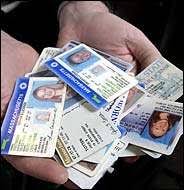Have a question? Give us a call: +1 (602) 672-1532
ID cards
Outline:
1. Introduction
- Brief overview of ID cards and their historical evolution.
- Importance of identification in modern society.
- Emerging needs in security, privacy, and access control that ID cards address.
2. Detailed Product Analysis
- Types of ID Cards: Overview of various ID cards (e.g., magnetic stripe, smart cards, RFID, and biometric).
- Technological Features:
- RFID and NFC capabilities for contactless access.
- Biometric authentication including fingerprints, facial recognition, etc.
- Data storage and encryption: Explains security measures in storing sensitive information.
- Security Features:
- Encryption standards, holographic images, UV inks, and anti-counterfeiting technologies.
- Importance of secure data handling and privacy compliance (e.g., GDPR).
- Customization Options: Design options, branding elements, and personalization for corporate, government, and educational sectors.
3. Market Analysis
- Current Market Trends:
- Growth in demand for secure, multifunctional ID cards.
- Increasing adoption in sectors such as healthcare, education, finance, and government.
- Regional Market Insights:
- Key markets in North America, Europe, Asia-Pacific, and emerging economies.
- Technological Advancements Driving Growth:
- Development of biometric technology, increased use of IoT, and cloud integration.
- Challenges:
- Addressing privacy concerns.
- Balancing security with user convenience and ease of access.
4. Target Audience
- Corporate Sector: Companies needing employee ID cards for access control and secure transactions.
- Education Sector: Universities and schools for student identification, access to resources, and campus security.
- Government and Law Enforcement: National ID programs, law enforcement identification, and driver’s licenses.
- Healthcare Providers: For patient identification, access to medical records, and administrative efficiency.
- Event and Facility Management: For guest access, event management, and attendee tracking.
5. ID Card Features and Innovations
- Security Innovations:
- Biometric-enabled ID cards, multifactor authentication.
- Tamper-evident features and self-destroying cards for high-security areas.
- Sustainability Aspects:
- Eco-friendly materials and recycling initiatives in ID card production.
- Integration with Smart Technology:
- Cards linked with mobile apps, digital wallets, and cloud-based access control systems.
- Flexibility in Use:
- Multi-functional cards combining access control, payment, and identification in one card.
6. Benefits of ID Cards Across Different Sectors
- Enhanced Security: How ID cards contribute to security, from access control to data protection.
- Operational Efficiency: Streamlining processes in sectors like healthcare, education, and corporate environments.
- User Convenience: Advantages of contactless and mobile-integrated ID cards.
- Cost Savings: Reduction of manual tasks and efficient resource allocation.
7. Case Studies and Success Stories
- Educational Institution: Use of ID cards for student and faculty identification, building access, and campus safety.
- Corporate Example: Implementation of ID cards for secure building access and employee attendance.
- Healthcare Facility: Using ID cards for patient tracking, medical record access, and secure transactions.
8. Future of ID Cards: Trends and Predictions
- Biometric Cards: Growth of fingerprint and iris-based ID cards.
- Digital ID Integration: Convergence of physical and digital ID cards for seamless, mobile-first identification.
- Blockchain and ID Verification: The role of blockchain in enhancing ID card security.
- Artificial Intelligence: How AI is shaping the future of ID card security and personalization.
9. Challenges and Considerations in the ID Card Industry
- Security Risks: Addressing potential vulnerabilities like hacking and unauthorized access.
- Privacy Concerns: Balancing user privacy with security.
- Cost of Technology: Weighing the expenses of high-tech ID cards against benefits.
- Regulatory Compliance: Navigating laws like GDPR to ensure ID card solutions remain compliant.
10. Conclusion
- Summarize the importance and evolution of ID cards.
- Emphasize their role in future security, convenience, and technological advancement.
- Encourage businesses and sectors to consider ID cards as integral to modern security strategies.
Related News
Read More >>
 South Carolina Fake ID
South Carolina Fake ID
A comprehensive guide on South Carolina Fake IDs, offering insights into the product‘s features, the...
 Québec Fake ID
Québec Fake ID
This article delves deep into the world of Québec Fake IDs, discussing the product‘s defining featur...
 Fake IDs
Fake IDs
In a world where identity holds the key to access and freedom, the creation and use of fake IDs have...
 Scannable Illinois Fake ID
Scannable Illinois Fake ID
Explore the essentials of scannable Illinois fake IDs. From their features and market demand to safe...
 Illinois Fake Driver’s License
Illinois Fake Driver’s License
Dive into the essential aspects of Illinois fake driver’s licenses. This guide covers product featur...
 Arizona Fake ID, Buy Arizona F
Arizona Fake ID, Buy Arizona F
Explore the ins and outs of Arizona fake IDs. This comprehensive guide covers everything from produc...
 Maryland market
Maryland market
Explore the Maryland market in depth with insights on consumer needs, market trends, unique product ...
 Buy New Jersey Fake ID
Buy New Jersey Fake ID
If you‘re considering buying a New Jersey fake ID, it‘s essential to know what sets a quality ID apa...
